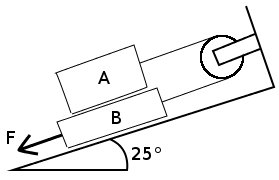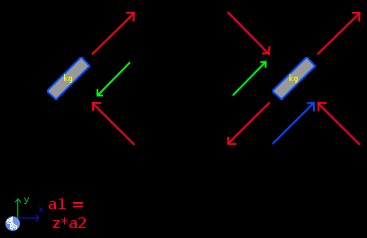Next: Example 12, Previous: Example 10, Up: Examples dynamics of particles [Contents][Index]
11.11 Example 11
An A block of 23 kg, is above a B block of 17 kg, as show the image. If the friction coefficient in all surfaces is 0.18, and F force is of 235 Newtons, which is the acceleration of the block A? Which is the stress in the string?

Solution with FisicaLab
Erase the content of the chalkboard and select the SI system. And add the necessary elements to make the free body diagram of each block. As show the image below:

We assume that the system leaves the rest, and assume a time of 0.5 seconds. Then to the element Stationary reference system write:
- g
9.81
- t
0.5
To the block that correspond with the A block, write:
- Name
A
- m
23
- ang
25
- a
aA
- vi
0
- vf
vfA
- d
dA
- Relative to
sf
To its normal:
- f
nA
- ang
65
To the element Friction between blocks write:
- N
nA
- u
0.18
- ang
25
To the force that correspond with force applied to the string, write:
- f
t
- ang
25
Now, to the B block, write:
- Name
B
- m
17
- ang
25
- a
aB
- vi
0
- vf
vfB
- d
dB
- Relative to
sf
To its normal:
- f
nB
- ang
65
To the friction with the plane:
- N
nB
- u
0.18
To the friction with A block, the element Friction between blocks, write:
- N
nA
- u
0.18
- ang
25
To the applied force of 235 Newtons, write:
- f
235
- ang
25
To the force that correspond with force applied to the string, write:
- f
t
- ang
25
To the force applied to the A block (the normal reaction):
- f
nA
- ang
65
And to the relation between the accelerations:
- a1
aA
- a2
aB
- z
-1
Now click in the icon Solve to get the answer:
nB = 355.635 N ; t = 173.848 N ; nA = 204.490 N ; aA = 1.812 m/s2 ; aB = -1.812 m/s2 ; vfB = -0.906 m/s ; dB = -0.227 m ; vfA = 0.906 m/s ; dA = 0.227 m ; Status = success. WARNING: Check that the sense of friction forces is opposite of the movement sense (when correspond).